Your cart is currently empty!
Maiolica, Majolica, and Faience – What’s the Difference?
Published:
Last Updated:
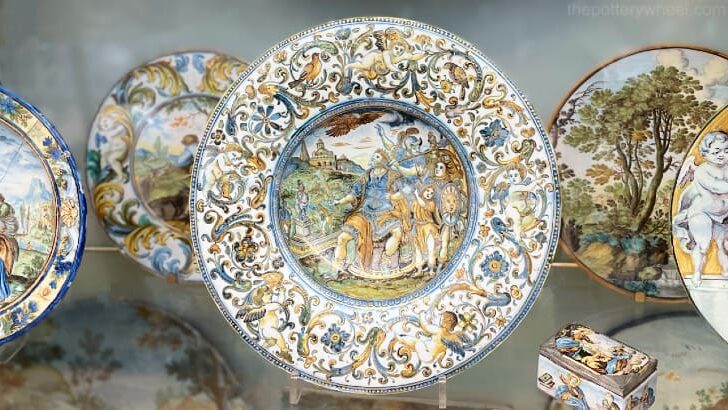
Affiliate Disclaimer
As an affiliate, we may earn a commission from qualifying purchases. We get commissions for purchases made through links on this website from Amazon and other third parties.
The terms maiolica and majolica are often used to refer to the same thing. And the word faience is sometimes used as an umbrella term for majolica and maiolica! So, is there any difference between maiolica, majolica, and faience?
Maiolica, majolica, and faience are all words that are used to refer to a broad category of tin-glazed earthenware. Maiolica is the original Italian name and majolica is an English version of the word maiolica. Faience is the French term used to refer to the same type of ceramic ware.
However, within these broad definitions, there are interesting differences and histories that distinguish the three terms. We will take a look at the similarities and differences between maiolica, majolica, and faience below.
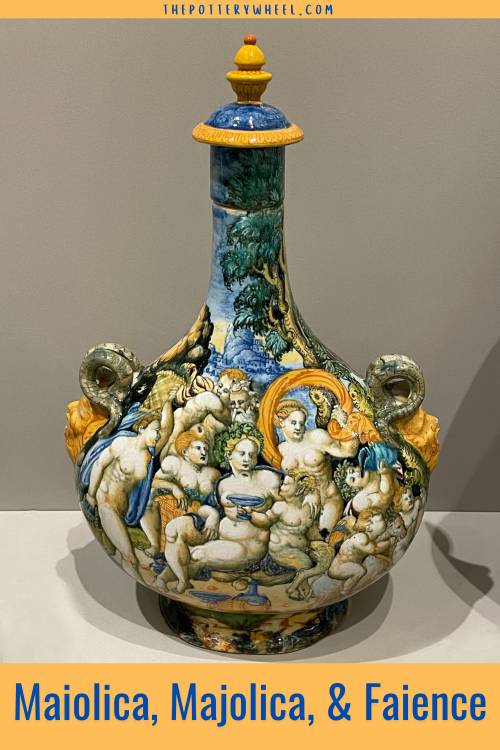
But before we get into these differences, let’s take a quick look at what tin glazed earthenware actually is.
Tin-glazed Earthenware
Pottery glaze is the hard glass-like surface that covers and decorates ceramics. It’s made up of three basic ingredients, which are silica, alumina, and a flux. Metallic oxides can be added to change its color.
These ingredients are mixed up with water and then applied to the pottery. The pottery is then fired in a kiln at a temperature of 1832F (1000C) and over. In the hot temperature of the kiln, the glaze melts onto the pottery surface.
The flux in the glaze lowers the temperature at which the glaze melts. It also affects the color, strength, and overall look of the finished glaze. One of the most common materials used as a flux in the past was lead oxide. It’s thought that lead was first used in pottery glaze in China around 475-221BC (source).
Around this time, glazes were either transparent or semi-opaque. However, it was found that if tin oxide was added to the glaze mixture, it would become an opaque white color once fired. Tin glaze is a lead glaze with a small amount of tin oxide.
Earthenware clay is often buff, red, orange, or brown colored, and the tin glaze covered the underlying clay body to create white ceramic ware.
Tin glazing has been around for centuries. There is evidence that tin glazing was being used in the 9th century AD in Iraq and Western Iran. But, archeologists have also found evidence that tin glazed wares were being made in the 8th century AD in Egypt (source).
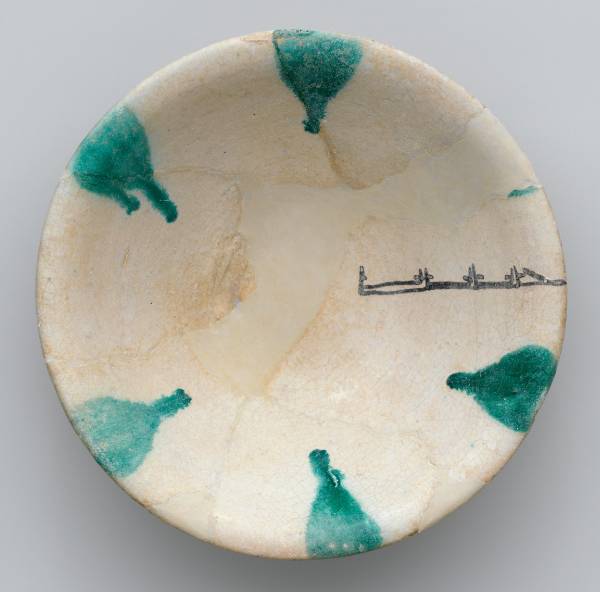
Image courtesy of The Met Museum. Public Domain.
The beauty of tin glaze is that it provides a clean white background on pottery onto which decorations can be painted.
Tin Glazed Maiolica
Maiolica pottery is tin-glazed earthenware. The process of making maiolica involves firing the pottery twice. In the first fire, the undecorated pots are converted from raw clay to hard ceramic ware. This is called the bisque or biscuit fire.
The pots are then painted with white tin glaze. This is allowed to dry on the surface of the pottery. Once it is dried, the glaze provides a hard but slightly powdery surface that can be painted. Maiolica pottery was painted with metallic oxides suspended in water.
The decorated pottery was then fired a second time and the glaze would melt onto the ceramic surface. During the glaze fire the metal oxide decoration fused into the glaze. This is known as the glaze fire.
As mentioned above, one of the benefits of tin-glazing was that it covered the color of the underlying clay body. But another advantage was that it provided a stable base for the painted decoration. Metal oxides painted on tin glaze tend to stay where they are when they are fired.
In contrast, colored lead glazes tend to move about when they are fired, and different colors have a tendency to run and bleed into one another.
The History of Maiolica
The word ‘maiolica’ is an Italian word, and it is used today to refer to tin-glazed earthenware created in Renaissance Italy from the 12th century onwards.
However, the origins of Italian maiolica stretch back to 8th century Spain. In 711AD the area that is now known as Spain was conquered by the Moors, a group of North African Muslims. The Moors brought with them a new set of ceramic techniques to Spain.
It’s thought that tin-glazed pottery was already being made in Spain when the Moors arrived (Hamer and Hamer). However, what did change was the way that Spanish pottery was decorated.
In the following centuries, Spanish pottery took on an Islamic look and feel. There was an emphasis on geometric shapes and patterns.
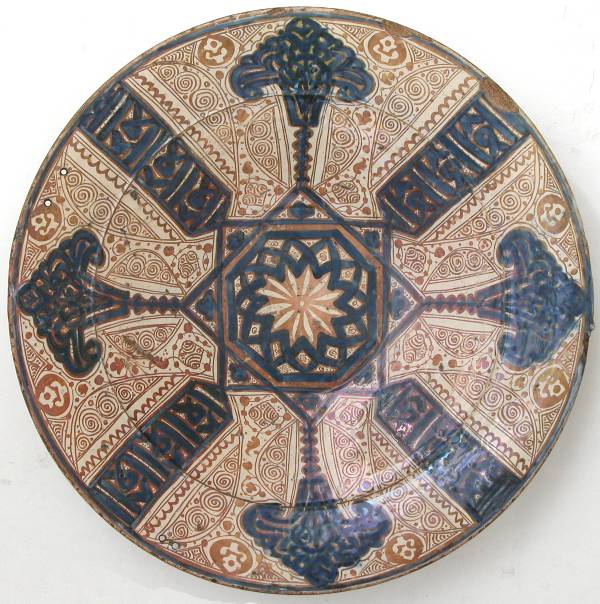
Probably Manises, Valencia, Spain.
Image courtesy of The Met Museum, Public Domain.
Spanish potters also perfected the Islamic technique of decorating their pottery with metallic lusters. This came to be known as Spanish lusterware. By the 13th century, exquisite Spanish lusterware was produced mainly in Malaga. However, soon after, other important seats of production emerged including Valencia (source).
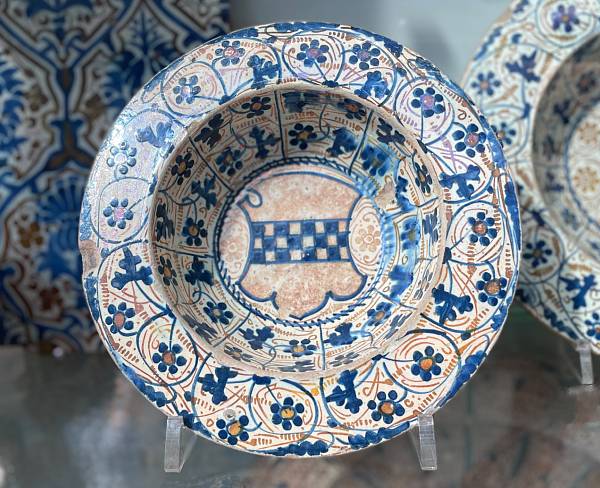
Dated 1430-70.
Located at the V&A Museum.
Spanish lusterware was exported throughout Europe and was in high demand. It’s now called Hispano-Morsque ware.
One of the countries to which Spanish lusterware was exported was Italy. Exports started to arrive in Italy in the 15th century and began to influence the way that Italian pottery was made.
Italian Maiolica
The term ‘maiolica’ was originally used in Italy to refer to tin-glazed lusterware. There has been speculation about where the name ‘maiolica’ comes from.
One account states that lusterware came to be called maiolica because it was imported to Italy through the island of Majorca. However, another suggestion is that the name arises from the Spanish term ‘obra de Mallegua’, which was used to refer to their lusterwares (source).
The word maiolica was first used to refer to lusterware, however, it eventually came to be used to refer to all tin-glazed earthenware, whether it was decorated with lusters or not.
Imported Hispano-Morsque ware from Spain played a significant role in the development of Italian maiolica. However, lead glazing and tin-glazing was already an established practice in Italy. In fact, it had been going on since just before 1200.
Sometimes a clear lead glaze was applied to pottery that had been decorated with metal oxides. At other times tin oxide was added to the lead glazes to improve their quality.
This early medieval Italian pottery is sometimes called ‘proto-maiolica’, meaning original maiolica. It was made largely in Sicily and southern Italy and the decorations often included simple images of animals or coats of arms (source).
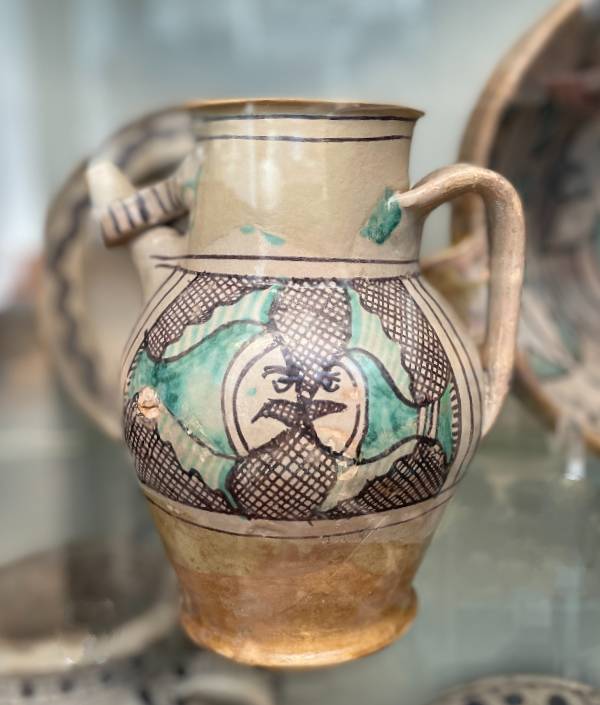
From Italy, probably Orvieto. On display at the V&A Museum
Istoriato Maiolica
In the 1300s Florence was a busy hub of Italian ceramic production. However, by 1500, Faenza had taken over as the key center of production for Italian pottery. It was around this time that the ‘istoriato style’ of pottery decoration emerged.
Istoriato decoration is when a particular scene is painted onto the surface of the ceramics. The subject was often a religious, historical, or mythical scene, and the decoration was designed to tell the story of the scene.
Istoriato designs were very finely painted. And it is these very precise depictions that are perhaps the most well-known style of Italian Renaissance tin-glazed maiolica.
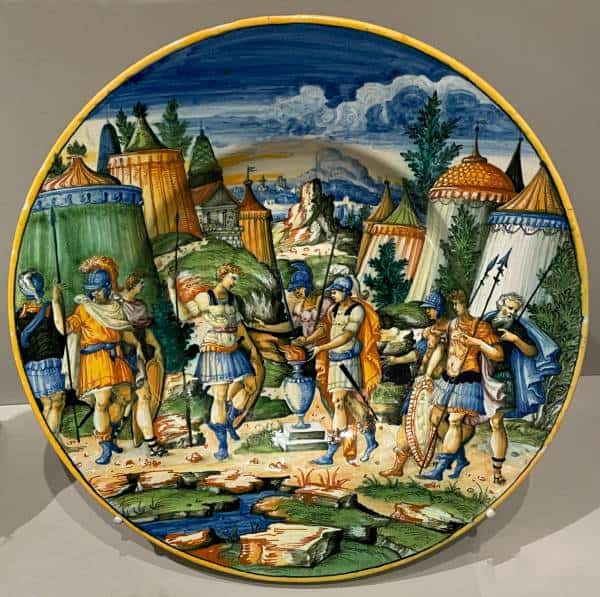
Probably from the workshop of Guido Fontana or Orazio Fontana.
On display at The V&A Museum
Painting decorations onto tin glaze lent itself to these highly detailed designs because the colors didn’t move about and bleed on the tin glazed surface when it was being fired in the kiln. That being said, painting with such precision on the powdery tin-glazed surface took a huge amount of skill.
Most of the time the istoriato painting covered the whole surface of the plate. But occasionally the depicted scene would be in the central portion of the plate and a decorative border was painted on the rim of the plate.
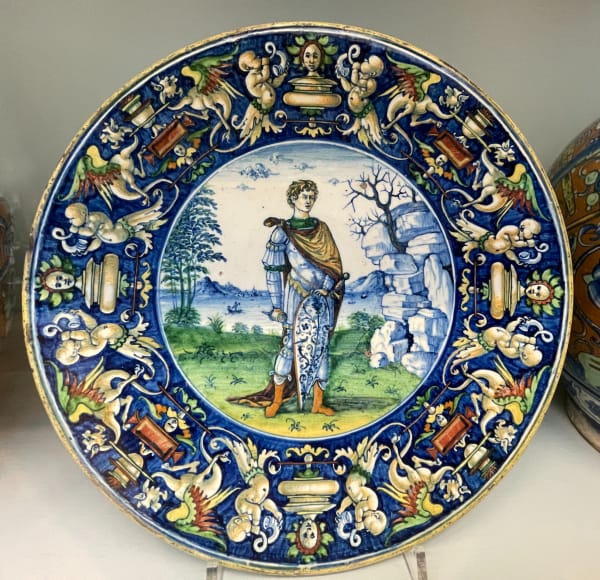
Painted by Jacopo, in about 1515. On display at The V&A Museum
One of the most well-known istoriato artists was Nicola di Gabriele Sbraghe, who signed his work Nicola da Urbino (source).
The Spread of Maiolica
In addition to Faenza, some of the other Italian cities that produced important Italian Renaissance maiolica include Urbino, Castel Durante, Pesaro, and Cubbio.
A lot of Italian maiolica was exported around the world, particularly to various destinations in Europe.
Also, Italian potters migrated and settled in different countries, taking their skills and techniques with them. As a result, the Italian methods of tin glazing became adopted by other countries too.
One such country was the Netherlands. Italian pottery had been exported to Brugge and Antwerp since the early 15th century and in the late 15th century, a number of Italian potters relocated to Antwerp.
In the early 16th century Antwerp was a booming hub of trade, and many artists from across Europe relocated there. The Italian potters were part of this movement.
Although Antwerp is now part of Belgium, during the Renaissance period it was part of the Netherlands.
At the time the local Dutch potters were already producing simple earthenware pots and plates. These pieces were decorated with colored clay slip and covered with clear lead glaze.
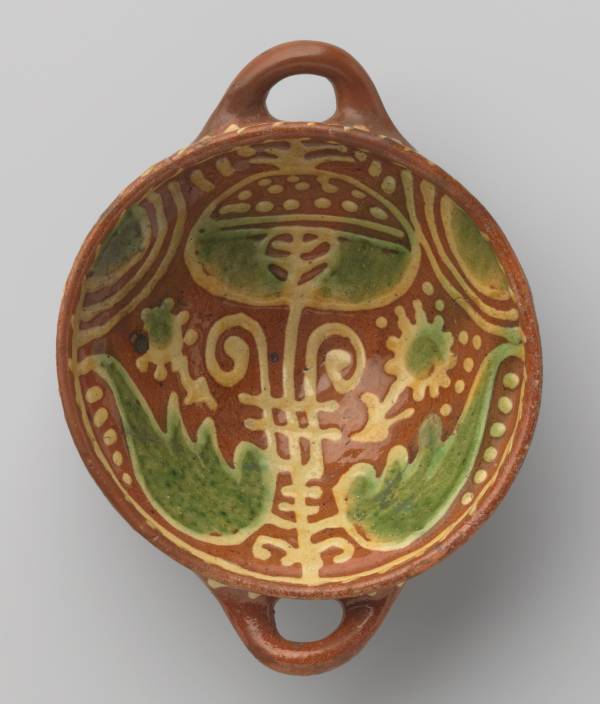
Holland, 1600-1699.
Image courtesy of Rijksmuseum.nl. Public Domain.
The earliest use of tin glazing in the Netherlands dates back to the early 16th century, which coincides with the arrival of the Italian maiolica potters.
Gradually the local Dutch potters began to produce their own maiolica. In time, the Italian and Dutch maiolica potters began to move to other areas in the Netherlands including Haarlem and eventually Delft.
Delftware – The Dutch Answer to Maiolica
The Dutch potters continued to hone their skills in tin-glazing. At the time tin-glaze was more expensive to produce than lead glaze, so, usually, only the top surface of the Dutch earthenware was covered with tin-glaze. The underside of the plates was usually coated with a clear lead glaze.
However, in the 17th century, there was a big increase in the amount of Chinese porcelain that was being imported into the Netherlands. The Chinese porcelain was pure white all over and decorated with refined cobalt oxide blue designs.
Chinese porcelain was very popular with the wealthy in Europe and the increase in its availability was a threat to the local Dutch pottery manufacturers.
At the time, the Europeans had not yet figured out how to make white porcelain clay. To deal with the competition from white Chinese porcelain, the Dutch potters began to cover the whole of their earthenware pieces with tin glaze.
This was done in an attempt to copy white Chinese porcelain. They also began to decorate the tin-glazed surface with cobalt blue oxides to copy the Chinese-style designs. This style of imitation Chinese ware has become known as chinoiserie.
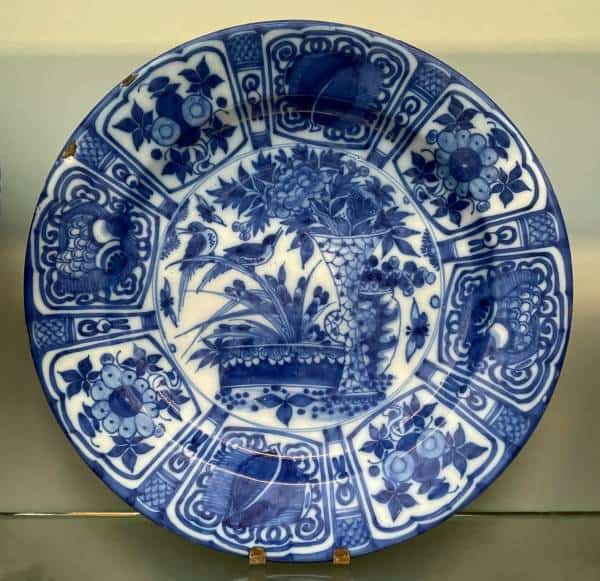
Tin glazed earthenware in the style of Chinese porcelain.
On display at the V&A
Much of the Dutch innovation around producing pottery that would compete with Chinese porcelain imports was centered around the city of Delft. It’s for that reason that Dutch tin-glazed ware became known as Delft Pottery or Delft Ware. You can read more about Delftware here.
Although Delftware began as an imitation of Chinese porcelain, over time, the Delftware potters developed their own style. Gradually the style of Delftware began to reflect native Dutch themes, designs, and styles.
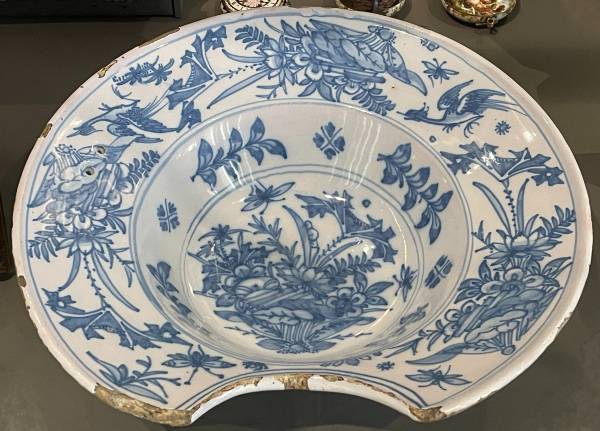
Dutch Republic, now the Netherlands (Delft).
On display at The V&A Museum
Majolica – The British Answer to Maiolica
One of the other countries to which Italian pottery was being exported was Britain. In the 16th century, these exports were called Galleyware in Britain.
The name Galleyware came about because Italian maiolica was exported from Venice to Western Europe by ship (or galley). The accounts for the name Galleyware.
In time local potters in Britain began to produce their own tin-glazed ware. Some of the key areas of production were Bristol, Liverpool, and Lambeth in London. The word Galleyware (sometimes spelled Galliware) was then used to refer to tin-glazed British earthenware and also imports from the Netherlands.
In 1571 some Dutch potters relocated from Antwerp to London and brought their tin-glazing techniques and designs. This marked the beginning of what came to be known as English Delftware. The production of English Delftware took off from around 1630 and retained its popularity well into the 18th century (source).
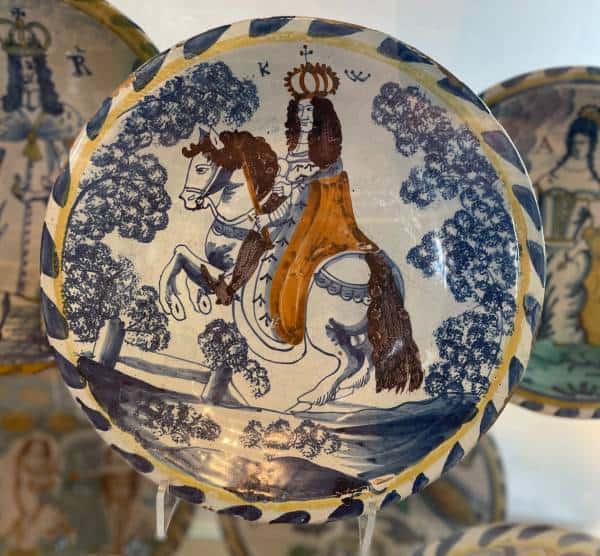
Probably made in London 1689-1705. On display at The V&A museum.
Maiolica or Majolica?
Galleyware and English Delftware were both forms of tin-glazed earthenware or maiolica. However, in the 17th century, the English started to use the term ‘majolica’.
Majolica is an anglicized version of the word ‘maiolica’ and it came about partly because of the arrival of the letter J in the English alphabet.
The letter J had been in existence for centuries, and for a long time, it was used in a similar way to the letter I. Around the 14th century, scholars began to separate the letter J from I, but it wasn’t until the 17th century that J became a letter completely in its own right (source).
It was at this point that the word ‘majolica’ became commonly used to refer to maiolica in England in in other parts of the world too. Majolica and maiolica mean the same thing – same pottery different consonants!
However, to confuse matters, in the 19th century the term Majolica started to be used to refer to a different kind of ceramics altogether. Let’s take a look at this new use of the word majolica now…
Colored Lead Glazed Majolica
Around the middle of the 19th century, British ceramics manufacturers were producing tin-glazed earthenware in the style of Italian Renaissance maiolica. As mentioned above, this was called majolica.
An important ceramics manufacturer at the time was the Minton factory. Like others, they produced tin-glazed majolica too.
However, around 1849, Mintons began producing another earthenware product that was painted with vibrant-colored lead glazes rather than tin glaze.
These pieces were usually relief molded, meaning they had complex molded designs on the surface. The relief designs were then painted in a range of glaze colors. These lead glazes, designed by Mintons, were innovative because the colors didn’t run into one another when they were fired.
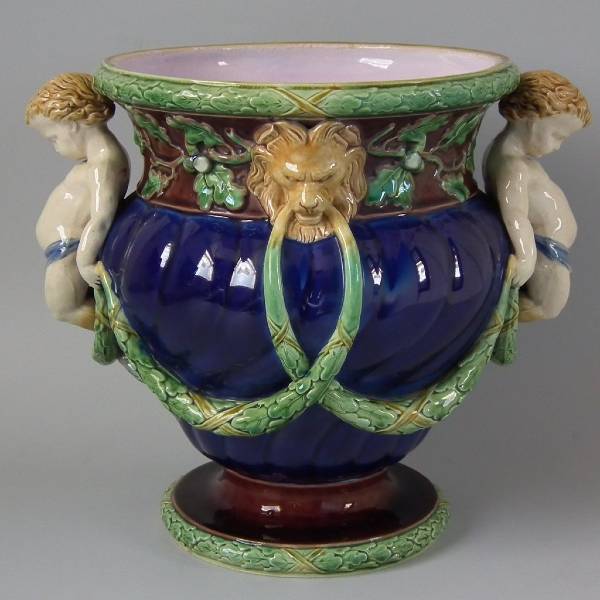
Image by David Madelena, CC BY-SA 4.0. Via Wikimedia Commons
At the start, Minton’s gave the new earthenware product the name Palissy ware. It was given this name because the style of the new product had some similarities with the ceramic artwork of the 16th-century French pottery Bernard Palissy.
It was launched as Palissy ware to the general public at the 1851 Great Exhibition in London. However, not long after that Mintons started referring to their Palissy ware as majolica.
This reference to majolica caught on, and soon the name majolica was being used to refer to colored lead glazed earthenware. You can read more about Victorian lead glazed majolica here.
Confusion About the Terms Maiolica and Majolica
By the Victorian period, there was some confusion about terms. The anglicized word ‘majolica’ was being used in many countries to refer to what was called maiolica in Italy and other countries.
But also, there was now a new product on the scene made using a different glazing process that was being called majolica too.
One interesting suggestion is that Mintons used the name majolica to refer to their new lead glazed earthenware precisely to cause confusion.
In the middle of the 19th century, there was growing concern about the dangers of working with lead in pottery products. Many pottery workers died young through lead poisoning, and there were campaigns underway to control the use of lead.
So, lead glazing was getting bad press. It’s thought that Mintons may have begun to call their new products Majolica to avoid drawing attention to the fact that they were made with colored lead glazes (source).
Faience – The French Answer to Maiolica
The name ‘Faience’ originates from France. These days, the term ‘la faience’ is usually translated to mean ‘earthenware’ or ‘terracotta’. But, originally it was derived from the French name for Faenze, the Italian city that produced and exported a lot of maiolica.
Since then, ‘faience’ has entered the English language, and it is now used to refer in a more general way to different styles of tin-glazed earthenware. The first known use of the word ‘Faience’ was in 1714 (source).
However, tin-glazed earthenware was produced in France from the 16th century onwards. Some of the key cities that produced French faience were Lyon, Rouen, Nevers, and Moustiers.
In the beginning, most of the faience was made by immigrant Italian potters and followed the istoriato tradition. However, the skills, techniques, and style spread far and wide across France in the following centuries and were taken up by local artisans.
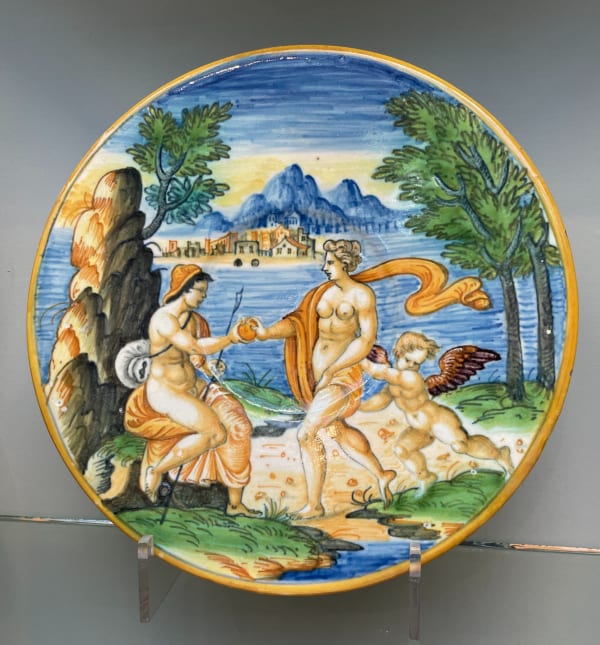
Plate with Venus and Paris, Nevers, France, from about 1641.
On display at The V&A Museum
Over time, there was a move away from the Italian istoriato style of decoration, and a French style of decorating faience developed. Wealthy aristocrats in Paris and Versailles would commission provincial potters to produce faience. This was then transported from the provinces to be used by the elite in wealthy cities (source).
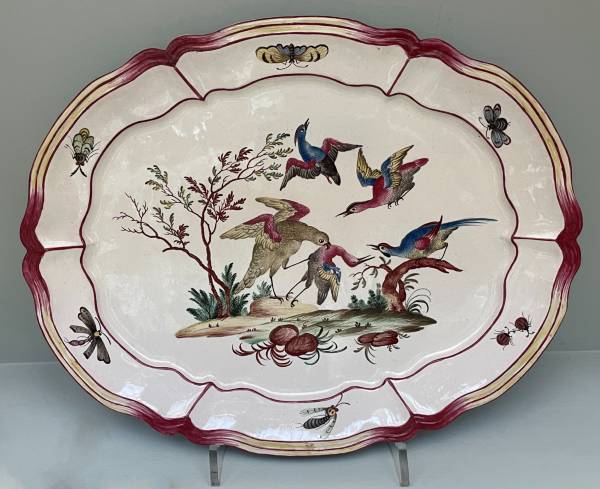
On display at the V&A Museum
Decorating Faience
Faience is often categorized as being ‘grand feu’ or ‘petit feu’. These terms refer to the processes involved in decorating and firing the pottery. Grand feu means ‘big fire’ and petit feu means little fire. It refers to the temperature and process involved in firing the pottery.
When a piece of earthenware has been fired using the grand feu technique, it is fired at a temperature of around 1832F (1000C).
Other types of clay like stoneware or porcelain can tolerate being fired at temperatures even higher than this. You can read more about different types of clay here. However, 1832F is a high temperature for earthenware. So, grand feu also means the same as ‘high fire’ in the tin glazing arena.
Grand Feu Faience
The grand feu process involves firing the bare pottery in a biscuit fire to turn the clay ceramic. The pottery was then coated with tin glaze and decoration was painted onto the raw tin glaze surface. This was then fired a second time in a glaze fire at 1832F.
The trouble is that not all colors used to paint on the ceramics would survive this high temperature. Many colors simply burn out when they get too hot. The colors that could survive the grand feu temperatures were brown, purple, yellow, blue, and green.
Grand feu firing was the main way of firing tin-glazed pottery until the 18th century. That’s one of the reasons why the colors used on tin-glazed earthenware up until this time had a more limited color palette.
Petit Feu Faience
However, in the 18th century, a new firing technique was devised. This involved firing the pottery three times. The first fire was the bisque or biscuit fire.
The pottery was then glazed with tin glaze and fired again at the usual ‘grand feu’ temperature of around 1832F. Sometimes colors that could cope with higher temperatures were applied to the tin glaze before the grand feu.
However, after the glaze fire, enamels were used to paint decoration onto the glaze fired surface. These enamels included colors that would be destroyed at high temperatures and also gold luster decoration.
After being decorated, the pottery was fired a third time at a lower temperature range of around 1100F (600C). The kiln used to fire for the third time was called a muffle kiln.
The more delicate colors would survive in the lower temperature of the muffle kiln. As a result, pottery decorated using the petit feu technique could be decorated with a wider range of colors.
The process of firing pottery for a third time in a muffle kiln was not just used on French faience. It was also a technique used notably on Dutch Delftware from the early 18th century onwards.
Different Uses of the Term Faience
Over the years, the word faience has been used to refer to some ceramics that are not tin-glazed earthenware. For example, the term ‘Architectural Faience’ refers to glazed terracotta that is used to decorate buildings. You can see some examples of Rookwood architectural faience here.
Faience is also used to refer to ancient Egyptian artifacts including, amongst other things, jewelry, beads, and figurines. Egyptian faience is actually made from ground quartz, salt, potassium, calcium, magnesium, and copper oxide (source).
It is usually coated with a green, blue turquoise glaze. The Met Museum points out that using the term Faience to refer to Egyptian artifacts is a misnomer because they are not ceramic and they are not tin-glazed. Nevertheless, the label has survived for want of a better alternative.
Final Thoughts
The terms maiolica, majolica, and faience can often be used interchangeably in a way that can be confusing and just a little bit intimidating. The way that each of these different forms of pottery has developed is complex and fascinating. I hope that the above has helped to tease out some of the similarities and differences between maiolica, majolica, and faience.



